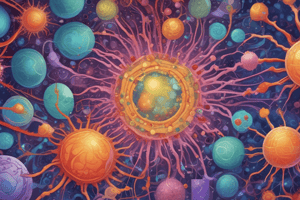Podcast
Questions and Answers
What does immunotolerance mean?
What does immunotolerance mean?
- The activation of immune responses to all encountered antigens
- A state of non-reactivity to an antigen after prior exposure (correct)
- The immediate destruction of foreign antigens by immune cells
- Permanent immunity tot all pathogens after initial exposure
Which of the following differentiates central and peripheral tolerance?
Which of the following differentiates central and peripheral tolerance?
- Central tolerance occurs in lymph nodes, while peripheral tolerance occurs in spleen
- Central tolerance involves mature cells, while peripheral tolerance involves immature cells
- Central tolerance eliminates self-reactive lymphocytes in primary organs, whereas peripheral tolerance regulates lymphocytes in tissues (correct)
- Both central and peripheral tolerance occur exclusively in the thymus
What is the role of positive selection in the thymus?
What is the role of positive selection in the thymus?
- To ensure that only T-cells that recognize self antigens survive
- To ensure that T cells that recognize self-MHC molecules survive (correct)
- To eliminate self-reactive T cells
- To generate antibodies against self antigens
Why is negative selection critical for immune function?
Why is negative selection critical for immune function?
What is the function of the AIRE protein in the thymus?
What is the function of the AIRE protein in the thymus?
How does the induction of tolerance differ between T cells and B cells?
How does the induction of tolerance differ between T cells and B cells?
What is the primary function of regulatory T (Treg) cells?
What is the primary function of regulatory T (Treg) cells?
Which cytokines are essential for the survival and function of Treg cells?
Which cytokines are essential for the survival and function of Treg cells?
Which other organs/systems play a role in modulation immune responses?
Which other organs/systems play a role in modulation immune responses?
Which mechanism contributes to peripheral T cell tolerance by rendering T cells functionally unresponsive?
Which mechanism contributes to peripheral T cell tolerance by rendering T cells functionally unresponsive?
Which condition typically leads to T cell anergy in peripheral tolerance?
Which condition typically leads to T cell anergy in peripheral tolerance?
How do regulatory T cells (Tregs) contribute to peripheral tolerance?
How do regulatory T cells (Tregs) contribute to peripheral tolerance?
What cytokine is crucial for the survival and functional maintenance of regulatory T cells (Tregs)?
What cytokine is crucial for the survival and functional maintenance of regulatory T cells (Tregs)?
What role does the inhibitory receptor CTLA-4 play in T cell regulation?
What role does the inhibitory receptor CTLA-4 play in T cell regulation?
Which ligands interact with the PD-1 inhibitory receptor to down regulate T cell response?
Which ligands interact with the PD-1 inhibitory receptor to down regulate T cell response?
What is the result of PD-1 interaction with its ligands on T cells?
What is the result of PD-1 interaction with its ligands on T cells?
What causes Autoimmune Polyendocrine Syndrome Type 1 (APS1)?
What causes Autoimmune Polyendocrine Syndrome Type 1 (APS1)?
What is a characteristic outcome of APS1 due to defective AIRE protein activity?
What is a characteristic outcome of APS1 due to defective AIRE protein activity?
In APS1, why are multiple endocrine organs affected?
In APS1, why are multiple endocrine organs affected?
Flashcards
Immunotolerance definition
Immunotolerance definition
A state where the immune system doesn't react to a specific antigen.
Central vs. Peripheral Tolerance
Central vs. Peripheral Tolerance
Central tolerance happens in the primary organs (thymus and bone marrow), while peripheral tolerance happens in the tissues.
Positive selection's role
Positive selection's role
T cells recognizing self-MHC survive in the thymus.
Negative selection's role
Negative selection's role
Signup and view all the flashcards
AIRE protein's function
AIRE protein's function
Signup and view all the flashcards
T cell vs. B cell tolerance induction
T cell vs. B cell tolerance induction
Signup and view all the flashcards
Regulatory T (Treg) cell function
Regulatory T (Treg) cell function
Signup and view all the flashcards
Key cytokines for Tregs
Key cytokines for Tregs
Signup and view all the flashcards
Peripheral organs in immune modulation
Peripheral organs in immune modulation
Signup and view all the flashcards
T cell anergy
T cell anergy
Signup and view all the flashcards
Anergy cause
Anergy cause
Signup and view all the flashcards
Treg cell's peripheral tolerance role
Treg cell's peripheral tolerance role
Signup and view all the flashcards
IL-2's role for Tregs
IL-2's role for Tregs
Signup and view all the flashcards
CTLA-4's role in T-cell regulation
CTLA-4's role in T-cell regulation
Signup and view all the flashcards
PD-1 ligands
PD-1 ligands
Signup and view all the flashcards
PD-1 interaction outcome
PD-1 interaction outcome
Signup and view all the flashcards
APS1 cause
APS1 cause
Signup and view all the flashcards
APS1 outcome
APS1 outcome
Signup and view all the flashcards
Multiple endocrine APS1 issues
Multiple endocrine APS1 issues
Signup and view all the flashcards

